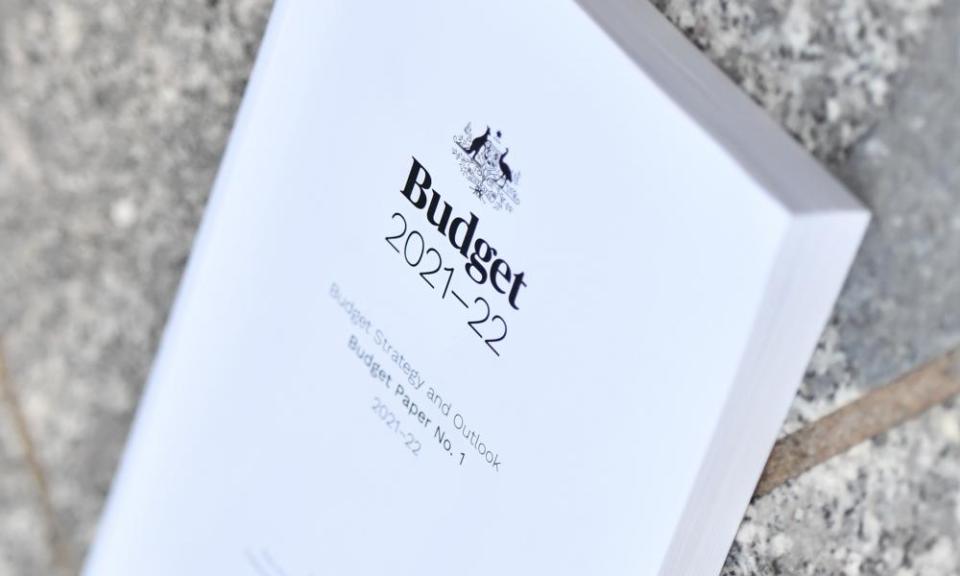‘Plenty more room to move’: three views on the Australian budget 2021

‘Back in the black’ a distant memory
Some are calling this a boring budget. I think that is far from the truth.
Yes, most of the big-ticket items were strategically dripped out in the lead-up, but it’s not until the budget is seen as a whole that you get a sense of just how big the shift has been for the Coalition.
When the treasurer said he wanted to use the budget to drive unemployment down until it has a “four in front of it”, he meant it.
Fiscal fortunes recovered to the tune of more than $104bn since December. Most of this was straight out the door. The government on Tuesday night announced more than $68bn in additional spending and $28bn in tax cuts to be delivered over the next four years.
“Back in the black” is a distant memory.
Fiscal policy is now the main game for driving the recovery. And even despite the spend, net debt is forecast to stabilise and then start coming down as a share of the economy over the next decade.
The other major shift is in what the government is choosing to spend on. Yes, the perennial infrastructure investment and business investment incentives featured again. But the big shift is the investment in social spending.
Significant measures were announced for aged care, mental health, childcare and women’s safety. They are much needed – the pandemic laid bare the deep structural problems in these sectors.
But even in these areas, the budget investment fell well short of what experts have estimated is needed for wholesale or transformative change to the way these services are delivered.
So while we shouldn’t underplay how much has shifted with this budget, if the government wants to be even more bold in building back better, there’s still plenty more room to move.
• Danielle Wood is CEO of the Grattan Institute
The budget leaves many stranded
After years of austerity, a pandemic and a recession, the federal budget provides much-needed investment in crucial community services but leaves many behind in crisis. It does nothing to address the severe shortage of social housing or raise social security payments above the poverty line.
The budget provides much-needed funding to finally start fixing some of the gaping holes in our aged care, childcare, mental health and domestic violence services. This long-overdue investment in care services will generate crucial jobs, overwhelmingly for women.
The government’s lower unemployment target is welcome and could be lowered further. While there is an expansion of training and local jobs programs, there are still 1.3 million people on jobseeker and youth allowance payments, half of them for over a year. Jobseeker is just $44 a day, and youth allowance even less.
We are deeply troubled by the $200m cut to employment services and the terrible $671m cut in income support for newly arrived residents, which would leave people to face destitution.
So far the government has given around $20bn dollars in personal tax cuts to people already in paid jobs for the next financial year, plus tens of billions in business tax incentives. But not a single cent more to people living in deep poverty, including women on low incomes.
Overall, the budget lifts essential services but leaves many stranded.
• Cassandra Goldie is CEO of the Australian Council of Social Service
Preventive health has been neglected
It is clear and remains essential that the Covid response continues to be properly resourced. However, investment in the wider areas of preventive health, and in the public health workforce, remain insufficient.
In Australia preventive health has been neglected. Fine words and good intentions rarely translate into meaningful long-term investment. This budget has not changed that.
The development of the nearly complete National Preventive Health Strategy gives us some encouragement, but ultimately will mean nothing unless there is a genuine commitment to dedicate funds into the work that will prevent disease in the first place.
Surely in 2021, after public health efforts and expertise has saved lives and protected our economy there are two obvious and essential courses of action.
Related: The 2021 federal budget reveals huge $311bn cost of Covid to Australian economy
Government must commit to a structural and sustained investment in public and preventive health, and the public health workforce desperately needs expansion. The overstretched cohort of skilled public health workers must be bolstered, with a clear plan to expand that workforce and recruit and train the next generation.
No one with expertise in our field believes this is the last public health crisis we will face. Now is the time to prepare a plan and invest in our capacity to prevent future outbreaks, or be ready to mitigate the consequences of future public health emergencies.
The public health sector has been patient. It has been constructive. It has presented the evidence and the arguments. But how long should we wait for a government to address this priority that will touch every life in the country?
The 2021 budget hints at action and future investment. Like the last budget, and the budget before, and the one before that, good intentions have not translated into real investment in public and preventive health.
• Adj Professor Terry Slevin is CEO of the Public Health Association Australia

 Yahoo Finance
Yahoo Finance 